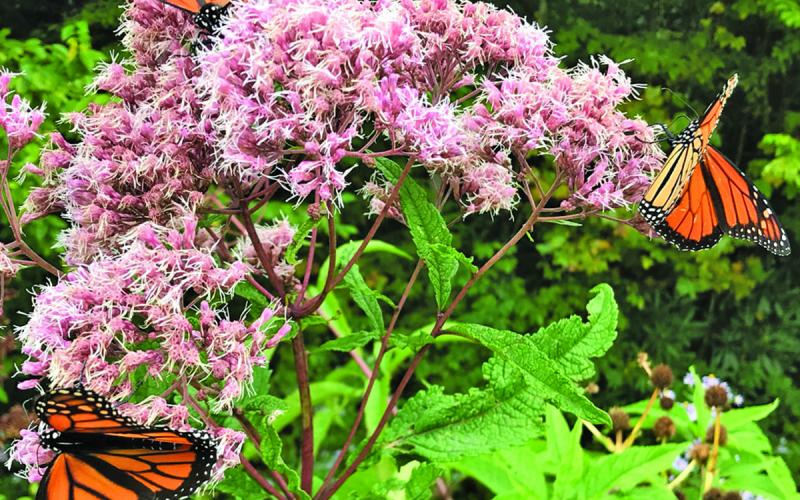The staff at the Highlands Biological Station has made it their mission to help save the monarch butterfly by providing pollinator gardens and tagging programs during the butterflies’ annual migration south to Mexico.
Jim Costa, executive director of WCU’s Highlands Biological Station and professor of evolutionary biology at Western Carolina University, said monarchs are already on the move through the area and will increase in numbers over next several weeks.
“Every fall, monarchs will cover thousands of miles to warmer climes for the winter,” he said. “The distinctive butterflies, with orange wings edged in black dotted by white spots, travel to locations they haven’t visited in their lifetimes.”
While not an endangered species, the monarch’s numbers have been down.
“The monarch butterfly’s numbers have been on a steady decline over the past decade,” said Jason Love, associate director at the Highlands Biological Station. “This is due in large part to the over-use of pesticides and the development of a brand of roundup that is more aggressive in battling weeds and saving soybeans and corn in fields in the Midwest.”
The roundup is more aggressive in killing weeds, but sparing the soybean and corn plants, Love said, “Unfortunately, one of those weeds is the milkweed plant, which is a host plant for the caterpillar.”
In addition to the pollinator gardens located throughout the Biological Station’s Highlands campus, Love also has participated in a program of tagging monarchs called Monarch Watch. It is a process that was discontinued this fall because of COVID-19 coronavirus social distancing concerns.
Pre-pandemic, students from Mountain View Intermediate School in Macon County would work with Love in a “Migration Celebration” each year to tag and release migrating monarchs as part of a project led by the University of Kansas.
“There seems to be a growing recognition by the general public of the importance of native plants for native wildlife, including insects,” he said. “While pollinator gardens are great, I think we sometimes forget the roles that plants play in acting as host plants for many insects, the monarch and the milkweed being prime examples.”
“In the past we have tagged monarchs with a sticker that’s about the size of a whole punch with a number on it,” he said. “It’s like a license plate for butterflies.”
The tags are retrieved after that specific generation of monarch has died.
Love said the monarch butterfly follows the milkweed plant to and from Mexico over several generations.
“You have to have milkweed for the butterfly to feed on,” Love said. “The Monarch is our charismatic butterfly that gets the majority of attention. We use the milkweed and butterfly to help focus attention on other species of butterflies as well.”
There are 107 different species of butterfly native in Macon County, Love said. “Each species has a specific plant or group of plants on which they feed. So we encourage people to plant native.”
After the young of an overwintering population matures in a small, mountainous area of Michoacan, Mexico, northern migrations begin in the spring and summer. The trip to the U.S and Canada, unlike the fall migration, will take several generations to complete. Vital for monarch survival and multigenerational development is the milkweed, a perennial often eradicated from lawns and gardens.
According to the monarchwatch.org website, the Monarch Watch Tagging Program is a large-scale citizen science project that was initiated in 1992 to help understand the dynamics of the monarch’s spectacular fall migration through mark and recapture.
Beginning in 1992, the Monarch Swatch Tagging Program helps answer questions about the origins of monarchs that reach Mexico, the timing and pace of the migration, mortality during the migration, and changes in geographic distribution. It also shows that the probability of reaching Mexico is related to geographic location, size of the butterfly, and the date - particularly as this relates to the migration window for a given location.
Western Carolina University does its part every year to aid the monarchs along their migration route.
“We have spots across campus that we tend by, well, not really tending that much at all, at least in terms of mowing or weed-eating,” said Vicky Heatherly, an agriculture and horticulture specialist with university Facilities Management. “We plant milkweed specifically to attract monarch butterflies and it benefits other species, too. It’s the only thing that provides habitat for monarchs to lay eggs, develop into caterpillars to chrysalids and then emerge as a butterfly. Plus, having native plants supports birds and other species.
“It may look messy at times, but it is nature at its best,” Heatherly said. “It’s another thing that makes Western special and why I love working here.”

